Global SEO involves many nuances and considerations that impact your organic visibility and the end user experience.
Not only does your international site involve different languages, SEOs must also think about location, cultural norms and expectations, and URL structures—just to name a few considerations.
Whether you're implementing global SEO as a result of international business expansion or seeing customer demand from other countries, we’ve put together a list of best practices for SEOs of global brands to follow to ensure their international SEO strategy is implemented correctly.
Global SEO Checklist
Step 1: Assess your most profitable foreign markets >
-
- Use Google Analytics (or your SEO platform) to analyze where your most converting traffic comes from.
- Conduct keyword research to identify the demand and traffic potential in the foreign market.
Step 2: Identify the search engines you need to target >
-
- Learn which search engines people use in the country or region you plan to target. Examples include:
- Russia: Yandex
- Japan: Yahoo! Japan
- China: Baidu
- Learn which search engines people use in the country or region you plan to target. Examples include:
Step 3: Consider local laws that will influence your site and its SEO and content >
-
- Laws and regulations can influence how you structure your website.
Step 4: Choose the right URL structure >
-
- ccTLD
- Subdomain
- Subdirectory
Step 5: Localize the site pages in the target language >
-
- Content considerations
- Hreflang
- Internal linking structure
Step 6: Track your global performance >
-
- Monitor SEO metrics to ensure your site ranks for the correct country.
- This signals success or failure for your international SEO strategy!
The Challenges of Global SEO
Unfortunately, many struggle with global SEO at first. Here’s something I always remind SEOs of when they ask me about developing an international SEO strategy:
A global SEO strategy isn’t just about updating the website. It’s about aligning it with what customers in your target location expect and are accustomed to.
That’s no small feat.
For example, foreign customers might use different terms to describe your products. As a result, literal translation won’t cut it for them. For some brands, this even meant having to change the product name.
Similarly, these people might respond to different copy than searchers you’ve been engaging so far.
And then, there’s the site setup, from your global sites’ URLs, to relevant tags, to local laws and regulations that you might have to adjust it to.
How to Do Global SEO
Global SEO includes many elements that are impossible to include in a single guide.
I’m hoping, however, that this list will offer you a good starting point to explore the issue further.
Just getting started with SEO? Check out our SEO roadmap + free template!
Step 1: Assess Your Most Profitable Foreign Markets
Departments within your organization may have conducted foreign market research already. You could base your next actions on their findings easily, but I recommend you go deeper.
At a minimum, compare their findings with your SEO data. This helps you prioritize international markets and focus on those that offer some SEO opportunity already.
To do this, analyze where your most converting traffic is coming from. Google Analytics offers many ways to access such data. You can analyze your audience, correlate the ecommerce data with traffic locations, and so on.
seoClarity users can integrate their GA data into the platform, so all analysis can be done in one central location. Use Site Analytics to see the traffic coming to each page of your site, or segment the data by device, country, engine, and more.
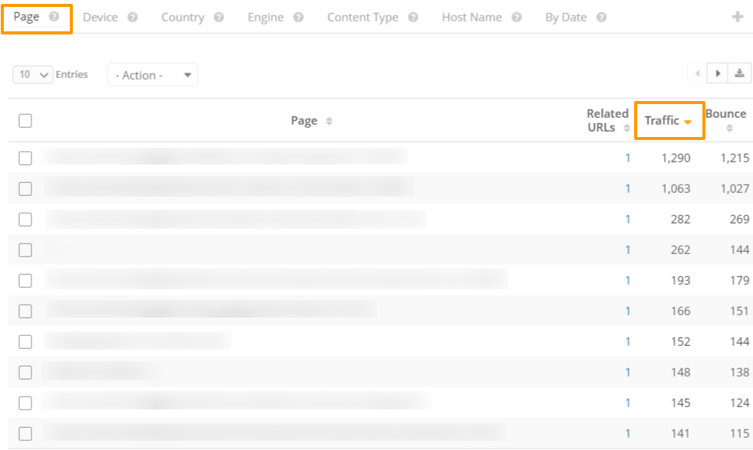
(Site Analytics within seoClarity showing the traffic to each page on a site.)
Next, identify the traffic potential in the foreign market. One way to do this is by analyzing your foreign competitors’ keywords and their search demand.
For example, let’s assume that you work for an online store selling running shoes. A quick translation tells me that customers in Poland would search for “buty do biegania” (translation: running shoes in Polish).
Conducting initial international keyword research confirms that it is indeed a phrase customers in that country use.
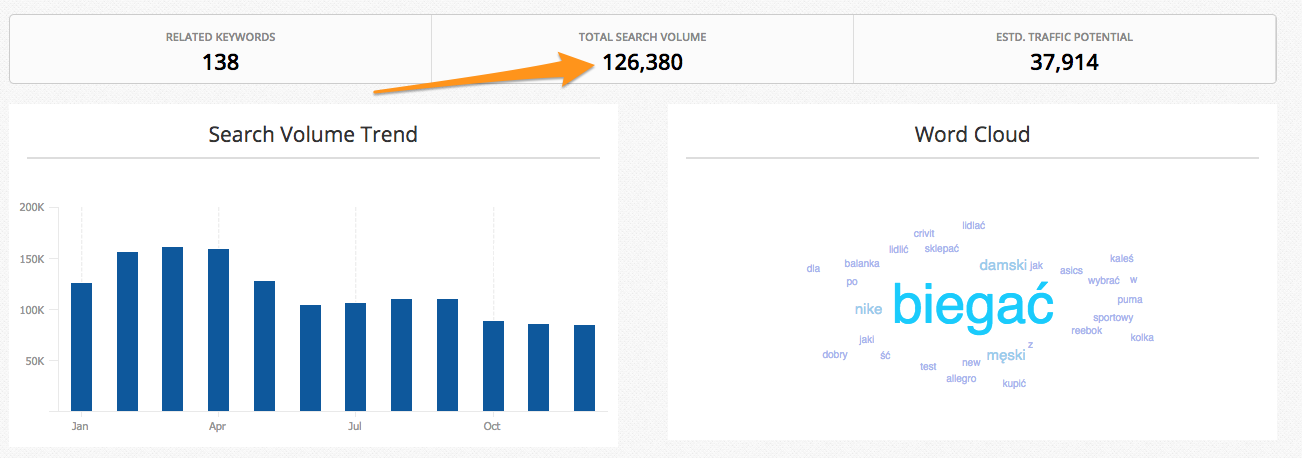
(seoClarity Search Volume report)
Then, a quick Google search for the term reveals local competitors:
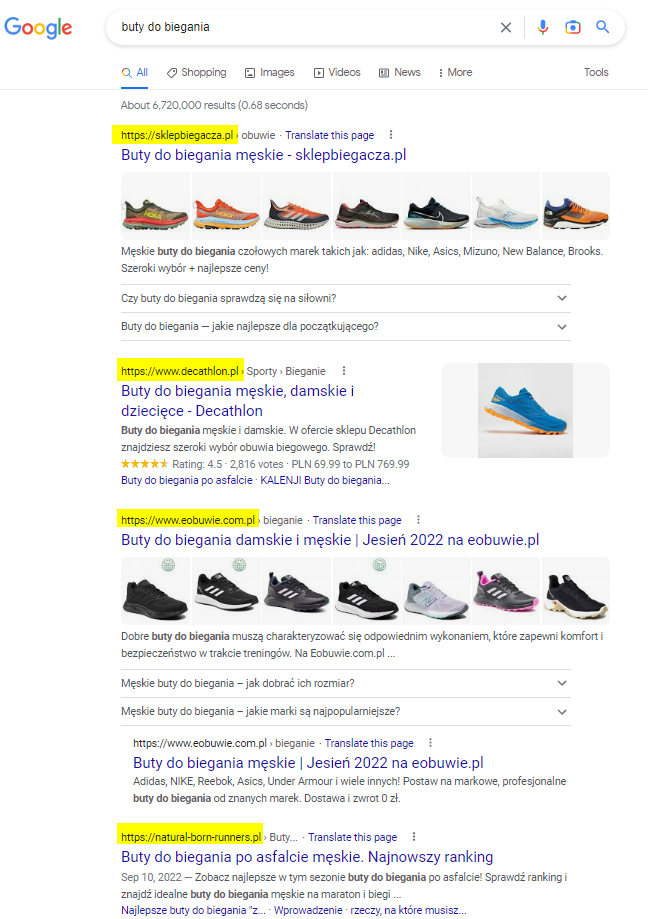
Using seoClarity’s Content Gaps, I can research those domains further to:
- Analyze their keywords,
- Identify the most viable phrases to target, and
- Learn more about the local market.
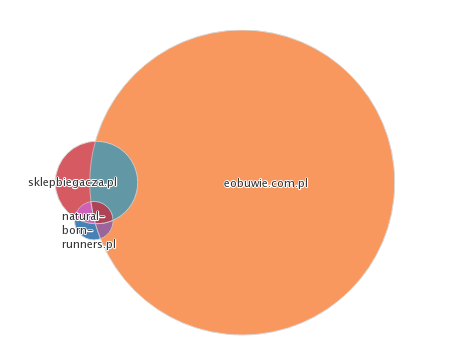
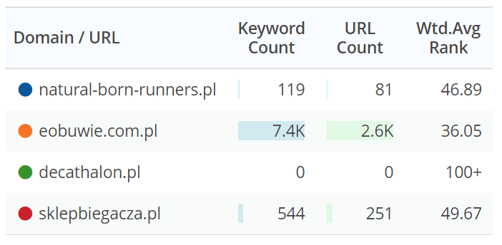 (Content Gaps shows opportunities between specified competitors.)
(Content Gaps shows opportunities between specified competitors.)
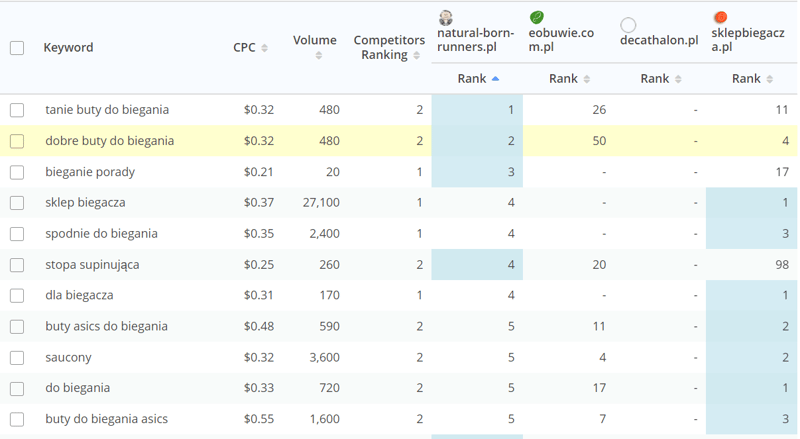 (This display on Content Gaps shows the terms that are ranking for the top competitors for the chosen keyword, “buty do biegania”.)
(This display on Content Gaps shows the terms that are ranking for the top competitors for the chosen keyword, “buty do biegania”.)
Step 2: Identify What Search Engines You Need to Target
For rank tracking purposes, you want to make sure that your content ranks for that search engine that is relevant.
Google is the dominant search engine in Poland, with 97.7% market share. Entering that market wouldn’t require you to focus on other search engines instead.
But if you were to go just a bit further to the east, to Russia, for example, you’d also have to optimize the site for Yandex (52% market share). Your potential customers in Japan might search for you in Yahoo! Japan (24% market share).
What’s important is that each of those search engines ranks content differently. You might have to consider their ranking factors when creating a localized version of the site. Analytics reveal what countries drive traffic to your site, so you can provide the correct user experience based on location.
seoClarity can track your rankings for Bing, Yahoo, Baidu and Yandex.
Step 3: Consider Local Laws and Regulations That Affect Your Website and Content
Many local regulations might force you to amend sections of your website.
GDPR is a good example. The new EU regulation requires companies to display relevant privacy policies to European customers. It also gives visitors a far greater control over how a website processes their data.
Take website cookies, for example. You must allow European visitors to choose what information you can collect about them, what purposes can you use it for, and also, be able to opt out of any of it.
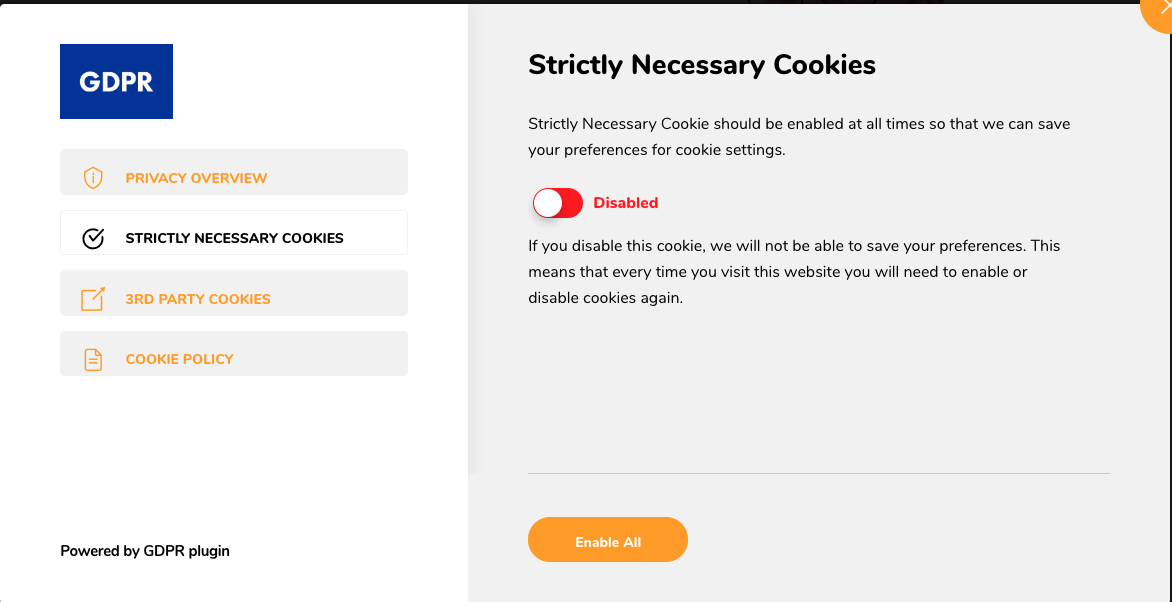
And so, before you begin amending the site, research any local laws that you might have to consider in the new content.
Step 4: Domain and URL Structure
There are a few options you can choose for your URL structure, but if implemented correctly, any will get the job done. You can choose between: ccTLD, subdomain, or a subdirectory.
There is no clear "best" method to choose here, but location targeting must be clearly defined. In any case, you can geotarget your website or localize it, which is explained down below.
To see which URL structure performs best, you can set up split testing and monitor the differences in SEO performance.
Step 5: Content: Localize and Optimize Pages in Target Languages
Unless you speak the target language, you’ll most likely need someone to help not only translate but also localize the content. Google Translate does not suffice!
I always recommend using either a local team or at least a native speaker living in your country. This way, you can ensure the copy is complete alignment with the target country’s customs, culture, and so on.
This includes taking into account different dialects of the language, as well as things like currency, time, slang, etc.
Content and link building considerations also take into account the hreflang tag, which works to ensure the proper language page is served in the right country.
Also be mindful of your internal link structure. Even if your internal links are just in the footer, it's still important to include them. Link to pages that are in the same language as the page which you link from. If you run a link audit, ask yourself: "Does it make sense for users to be led to this page?"
Hreflang again is relevant, as the pages that your internal links lead to need to be optimized for the end user experience.
Step 6: Set Up Tracking To Monitor Your Global SEO Performance
I’ve shared the main challenges with launching an international SEO strategy.
There is one more: knowing whether your site is ranking for each country correctly.
Typically, when we measure rankings, we focus on SEO metrics such as the number of pages ranking on the first page or in the top SERP positions. But, when you go beyond your usual location, you must also know if the right pages rank in a specific market.
Like, if your pages optimized for the UK do not show up in the US SERPs, and so on.
seoClarity lets you monitor rankings for every location you target. You can also track rankings in search engines other than Google.
Also, Clarity Audits lets you analyze the tag to identify and fix issues like the one I mentioned above.
You can also use this feature for testing the tag when you are working on launching the international sites and identify:
- Pages with hreflang tag,
- Content without the tag specified, or
- Assets with inconsistent tag.
If you’ve optimized your site for Global SEO correctly, and the right site is ranking for each country, only then you can consider your strategy a success.
The Two Approaches to International SEO
I want to touch on the issue of what approach to global SEO you should take.
As a matter of fact, you can target international search queries in two ways:
- Localize your website, or
- Geotarget your website.
Localizing the Website
In this approach, you translate your website’s content to your target languages. Then, you optimize each version for any local queries you’d like it to rank for.
As a result, you end up with multiple, separate versions of your site, each of them in a different language.
The benefit of this approach is being able to make the site relevant to your target audience completely. If done well, it can guarantee solid engagement with your international customers.
This approach does require optimizing various elements of the site in a foreign language. Your meta tags, for example, must be translated so well to ensure compliance with various cultural intricacies.
Similarly, each version of the site must feature a properly defined hreflang tag to ensure Google ranks the correct version of the site in the relevant region.
Recommended Reading: 4 Steps to Create an XML Sitemap with Hreflang Tags
But, as we’ve said before, hreflang is a signal, not a directive. Other factors can override it and push your other pages to rank. That’s why to ensure the correct page shows up in SERPs, you should also consider building links to local content, hosting your site on a local IP, and connecting with local search engines
On the downside, this approach requires you to manage multiple web properties. Assuming you don’t speak those target languages, each requires additional skills or help from a translator.
Geotargeting
This approach works if you target different locations that use the same language. A good example would be an online store selling products to all English-speaking countries that you want to position for each country separately.
The issues you’re facing here include different currency or language variations (different terms used in each country to denote something.)
When geotargeting, your focus should fall on the hreflang tag to ensure Google knows which pages to push in SERPs in each location.
The Importance of Global SEO Best Practices
Defining a minimum set of criteria or best practices to follow and iterating on those is crucial to guarantee the collective site is cohesive and the user experience is matched to that location and language.
Different site or URL structure nuances between locations or languages can slow down a process that should be streamlined as best as possible.
This can lead to scenarios where your target market is not seeing the correct URL or content which leads to a poor user experience and can impact the ability to get correctly indexed and show up in the SERPs.
Going Global With seoClarity
seoClarity is in the business of bringing SEO success to our clients all around the world. Our platform is built with special considerations and abilities that allow international companies to find success in organic search.
- Content Fusion: Our AI-powered content writer is capable of producing content briefs in 10 languages: English, Japanese, Swedish, Danish, German, Spanish, French, Norwegian, Dutch, and Finnish.
- Keyword Research: Three sources of SEP data to create the freshest, largest data set available: 30+ billion keywords updated weekly!
- Rank Intelligence: Accurate ranking tracking with unlimited keyword capacity with rankings in 180+ countries.
- Client Success: A dedicated Client Success Manager with the knowledge to operationalize your global SEO.
Conclusion
Sooner or later, most enterprise SEOs have to begin thinking of making their efforts global. Although the issue might seem intimidating at first, hopefully in this guide, I’ve provided you with a solid foundation to take your efforts further.
Further Resources on Global SEO
- The Ultimate Guide to International SEO for Enterprise Sites
- Why the Hreflang Tag is Essential to Global SEO
- 12 Common Hreflang Mistakes and How to Prevent Them
Editor's Note: This blog post was originally published in October 2018 and has been updated for accuracy and clarity.





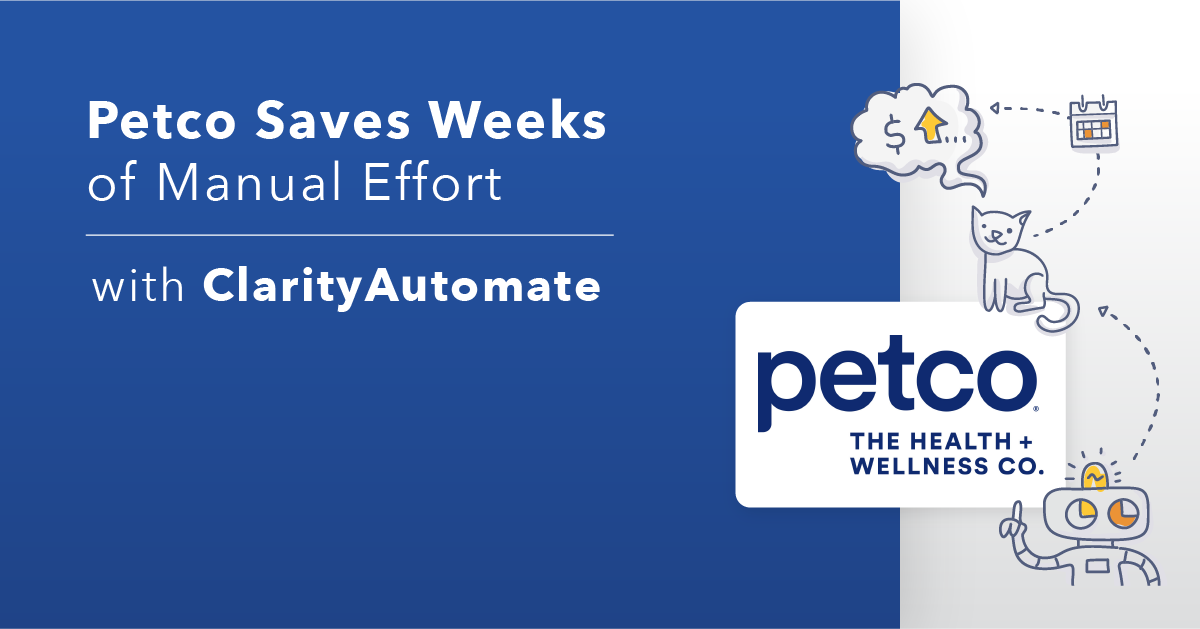

Comments
Currently, there are no comments. Be the first to post one!